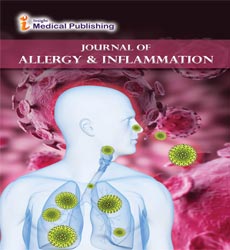Inflammatory Disease Effect to the Lungs during Pregnancy
Federico Romano
Federico Romano*
Department of Clinical Immunology, University of Messina, Messina, Italy
- *Corresponding Author:
- Federico Romano
Department of Clinical Immunology
University of Messina
Messina, Italy
E-mail: federicoromano@um.it
Received Date: September 07, 2021; Accepted Date: September 21, 2021; Published Date: September 28, 2021
Citation: Romano F (2021) Inflammatory Disease Effect to the Lungs during Pregnancy. Arch Inflamm Vol.3 No.1:4.
Asthma may be a long-term inflammatory illness of the airways of the lungs. It is characterized by variable and repeating side effects, reversible airflow obstacle, and easily activated bronchospasms. Side effects incorporate episodes of wheezing, coughing, chest tightness, and shortness of breath.
Asthma is thought to be caused by a combination of hereditary and environmental variables. Natural components incorporate exposure to air contamination and allergens. Other potential triggers incorporate medicines. Diagnosis is generally based on the design of side effects, reaction to treatment over time, and spirometry lung function testing [1]. Asthma is classified concurring to the recurrence of indications, constrained expiratory volume in one second, and peak expiratory stream rate [2].
Asthma is characterized by repetitive episodes of wheezing, shortness of breath, chest tightness, and coughing. Sputum may be created from the lung by coughing but is regularly difficult to bring up. Amid recovery from an asthma attack, it may show up pus-like due to high levels of white blood cells called eosinophils. Symptoms are worse at night and within the early morning or in reaction to work out or cold air. A number of other health conditions happen more frequently in individuals with asthma, including gastroesophageal reflux infection, rhinosinusitis, and obstructive sleep apnea [3].
Numerous natural variables have been related with asthma's development and worsening, including, allergens, air contamination, and other natural chemicals [4]. Smoking amid pregnancy and after conveyance is related with a more hazard of asthma like indications. Low air quality from natural components such as activity contamination or high ozone levels has been related with both asthma development and expanded asthma seriousness [5].
A set of three of atopic dermatitis, allergic rhinitis and asthma is called atopy. The more chance for creating asthma could be a history of atopic illness; with asthma happening at a much more prominent rate in those who have either dermatitis or hay fever. Asthma has been related with eosinophilic granulomatosis with polyangiitis, an autoimmune illness and vasculitis [6]. Asthma is the result of constant inflammation of the conducting zone of the airways, which is results in expanded contractability of the surrounding smooth muscles. This among other components leads to bouts of narrowing of the airway and the classic side effects of wheezing.
The chronic inflammation is related with airway hyper responsiveness that leads to repetitive episodes of wheezing, breathlessness, chest tightness and coughing especially at night or within the early morning. These episodes are generally related with broad but variable airflow obstruction within the lung that's frequently reversible either spontaneously or with treatment. Although asthma may be a chronic obstructive condition, it isn't considered as a portion of chronic obstructive pulmonary infection, as this term alludes particularly to combinations of disease that are irreversible such as bronchiectasis and emphysema.
An acute asthma worsening is commonly alluded to as an asthma attack. The classic side effects are shortness of breath, wheezing, and chest tightness. The wheezing is most regularly when breathing out, Whereas these are the essential indications of asthma. Signs happening amid an asthma attack incorporate the utilize of accessory muscles of breath, there may be a paradoxical beat, and over-inflation of the chest. A blue colour of the skin and nails may happen from lack of oxygen [7].
References
- Lemanske RF, Busse WW (2010) Asthma: Clinical expression and molecular mechanisms. J Allergy Clin Immunol 125: 95–102.
- Yawn BP (2008) Factors accounting for asthma variability: achieving optimal symptom control for individual patients. Prim Care Respir J 17: 138–47.
- Boulet LP (2009) Influence of comorbid conditions on asthma. Eur Respir J 33: 897–906.
- Kelly FJ, Fussell JC (2011) Air pollution and airway disease. Clin Exp Allergy 41: 1059–71.
- Gold DR, Wright R (2005) Population disparities in asthma. Annu Rev Public Health 26: 89–113.
- Jennette JC, Falk RJ, Bacon PA, Basu N, Cid MC, et al. (2013) 2012 revised International Chapel Hill Consensus Conference Nomenclature of Vasculitides. Arthritis Rheum 65: 1–11.
- Werner HA (2001) Status asthmaticus in children: a review. Chest 119: 1913–29.
Open Access Journals
- Aquaculture & Veterinary Science
- Chemistry & Chemical Sciences
- Clinical Sciences
- Engineering
- General Science
- Genetics & Molecular Biology
- Health Care & Nursing
- Immunology & Microbiology
- Materials Science
- Mathematics & Physics
- Medical Sciences
- Neurology & Psychiatry
- Oncology & Cancer Science
- Pharmaceutical Sciences
